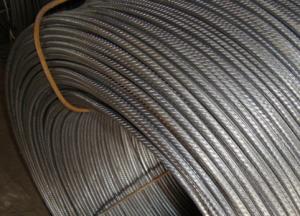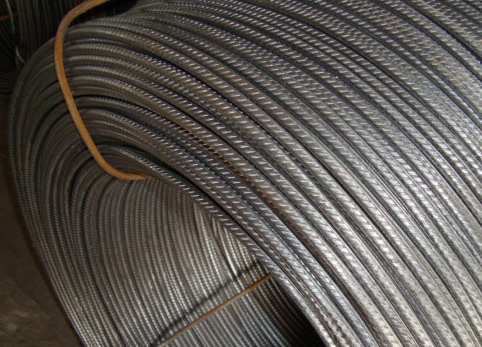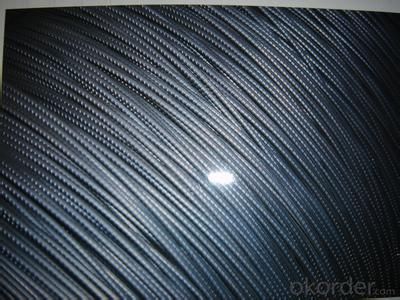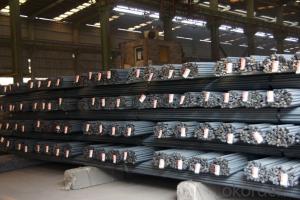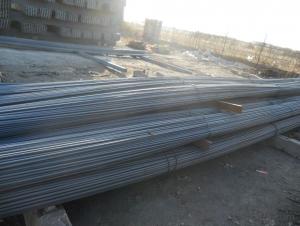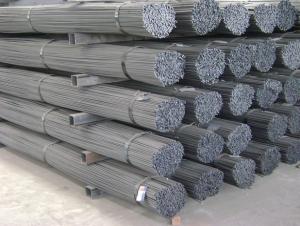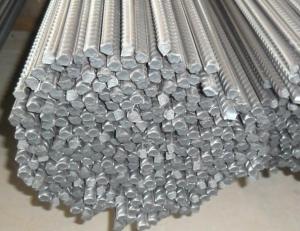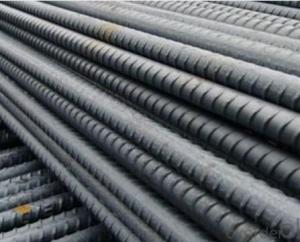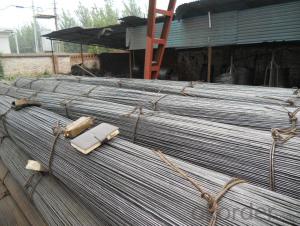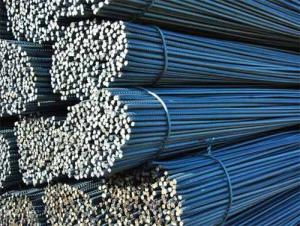Six mm Cold Rolled Steel Rebars with Good Quality
- Loading Port:
- Tianjin
- Payment Terms:
- TT or LC
- Min Order Qty:
- 50 m.t.
- Supply Capability:
- 15000 m.t./month
OKorder Service Pledge
OKorder Financial Service
You Might Also Like
Specifications of Six mm Cold Rolled Steel Rebars with Good Quality:
Name | Six mm Cold Rolled Steel Rebars | |
Diameter | 5mm, 5.5mm, 6mm, 6.5mm, 7mm, 8mm, 9mm, 10mm, 11mm, 12mm, | |
Length | 6M, 9M, 12M or as required | |
Price | Keep lower operating costs so as to offer competitive price for our clients | |
Label | to be specified by customer, generally, each bundle has1-2 labels | |
Application | Building, construction | |
Invoicing | Actual or Theoretical Weight Basis as buyer’s request. | |
Theoretical weight and section area of each diameter of Six mm Cold Rolled Steel Rebars with Good Quality as below for your information:
Diameter(mm) | Section area (mm²) | Mass(kg/m) | ||
6 | 28.3 | 0.222 | ||
Packaging & Delivery of Six mm Cold Rolled Steel Rebars with Good Quality:
Packaging Detail: products are packed in bundle and then shipped by container or bulk vessel, deformed bar is usually naked strapping delivery, when storing, please pay attention to moisture proof. The performance of rust will produce adverse effect.
Each bundle weight: 2-3MT, or as required
Payment terms: TT payment in advance or Irrevocable LC at sight.
Trade terms :FOB, CFR, CIF
Delivery Detail: within 45 days after received advanced payment or LC.
FAQ:
Q1: Why buy Materials & Equipment from OKorder.com?
A1: All products offered byOKorder.com are carefully selected from China's most reliable manufacturing enterprises. Through its ISO certifications, OKorder.com adheres to the highest standards and a commitment to supply chain safety and customer satisfaction.
Q2: How do we guarantee the quality of our products?
A2: We have established an advanced quality management system which conducts strict quality tests at every step, from raw materials to the final product. At the same time, we provide extensive follow-up service assurances as required.
Q3: How soon can we receive the product after purchase?
A3: Within three days of placing an order, we will arrange production. The shipping date is dependent upon the quatity, how many sizes you want and the plan of production, but is typically 1 month to 2 month days from the beginning of production.
Images of Six mm Cold Rolled Steel Rebars with Good Quality:
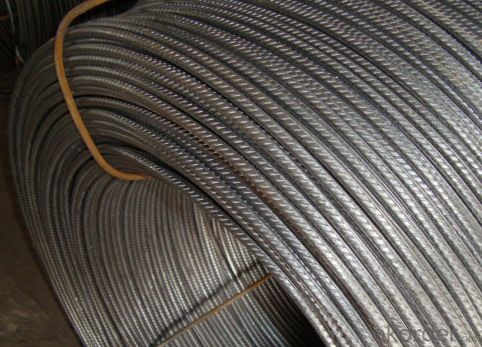
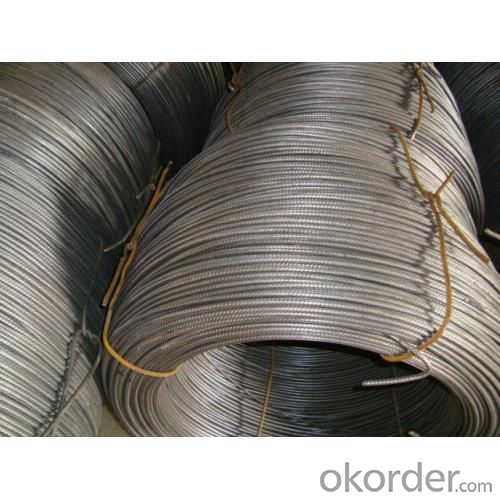
*If you would like to get our price, please inform us the size, standard/material and quantity. Thank you very much for your attention.
- Q: How do steel rebars impact the overall construction cost estimation process?
- Steel rebars can have a significant impact on the overall construction cost estimation process. They are a crucial component in reinforced concrete structures, providing strength and durability. The quantity and quality of steel rebars required for a project can influence the material cost, labor cost, and construction timeline. Accurate estimation of steel rebars is essential to ensure the project's structural integrity while avoiding cost overruns or delays.
- Q: What is the role of steel rebars in column and beam construction?
- Steel rebars play a crucial role in column and beam construction as they provide reinforcement, strength, and stability to the structure. In reinforced concrete construction, columns and beams are typically made of concrete, which is strong in compression but relatively weak in tension. This is where steel rebars come in. Rebars, also known as reinforcing bars, are long steel rods that are strategically placed within the concrete to counteract its weakness in tension. They are typically made of high-strength steel and are designed to withstand the tensile forces that occur in a structure. By adding rebars to the concrete, the resulting composite material can resist both compression and tension, making it much stronger and more durable. In column construction, steel rebars are placed vertically and tied together in a grid-like pattern. This reinforcement helps the column support the weight of the structure and resist vertical loads, such as the weight of the floors or roof above. The rebars also help to prevent the column from buckling or collapsing under these loads. Similarly, in beam construction, steel rebars are placed horizontally within the concrete beam. These rebars help the beam to resist bending and shear forces, which are common in structural elements that span across openings or support loads from above. By providing reinforcement, the rebars ensure that the beam remains stable and can safely bear the imposed loads. Overall, the role of steel rebars in column and beam construction is to enhance the strength, stability, and load-bearing capacity of the structure. They effectively improve the structural integrity of the concrete elements, allowing them to withstand the various forces and loads they will be exposed to throughout their lifespan. Without the presence of rebars, columns and beams would be much weaker and more susceptible to failure, compromising the safety and longevity of the overall structure.
- Q: How do steel rebars contribute to the crack-resistance of concrete?
- Crucial in improving the crack-resistance of concrete structures are steel rebars, also known as reinforcement bars. These rebars serve as a reinforcement system when embedded within concrete, aiding in the distribution and resistance of tensile forces. This is particularly important due to the relatively low tensile strength of concrete, despite its high compressive strength. The absorption of tensile stresses is the primary means by which rebars contribute to crack-resistance. Without rebars, these stresses would lead to the development of cracks in the concrete. By bearing the tension forces as the load is applied to the structure, the rebars prevent excessive tensile stress and subsequent cracking. This is especially crucial in areas subjected to bending or flexing forces. Additionally, the bond strength between the rebars and the surrounding concrete plays a role in crack-resistance. The presence of rebars improves this bond, preventing the separation or debonding of the concrete under stress. This ensures effective load transfer between the rebars and the concrete, further reducing the likelihood of cracks. Furthermore, steel rebars aid in controlling crack widths in concrete. Acting as a restraint when tensile forces are applied, the rebars limit the width of any cracks that may form. This prevents the cracks from widening and becoming more severe, preserving the overall integrity and durability of the structure. To summarize, steel rebars play a significant role in enhancing the crack-resistance of concrete by absorbing tensile stresses, improving bond strength, and controlling crack widths. Their presence within the concrete structure aids in the distribution and resistance of forces, preventing the formation of cracks and ensuring the longevity and safety of the construction.
- Q: What is the role of steel rebars in reducing concrete shrinkage?
- Steel rebars play a crucial role in reducing concrete shrinkage by providing reinforcement and controlling cracking. When embedded within the concrete, rebars help distribute stress and prevent the formation of large cracks. This reinforcement enhances the structural integrity of the concrete and minimizes shrinkage, leading to a more durable and stable construction material.
- Q: What are the different grades of epoxy-coated steel rebars?
- The different grades of epoxy-coated steel rebars are typically classified based on their yield strength, which can range from Grade 40 to Grade 80. These grades signify the minimum yield strength in ksi (thousand pounds per square inch) that the rebar can withstand before it deforms.
- Q: How are steel rebars classified based on grades?
- Steel rebars are classified based on grades according to the minimum yield strength they possess. The grade of a steel rebar indicates its strength and ability to withstand stress and loads. The most commonly used grades for steel rebars are Grade 40, Grade 60, and Grade 75. Grade 40 rebars have a minimum yield strength of 40,000 pounds per square inch (psi). They are typically used in general construction projects where high strength is not a primary requirement. Grade 40 rebars are suitable for light to moderate load-bearing structures such as residential buildings, sidewalks, and driveways. Grade 60 rebars have a minimum yield strength of 60,000 psi. They are the most commonly used grade for construction purposes and are suitable for a wide range of applications. Grade 60 rebars are used in reinforced concrete structures, bridges, highways, and commercial buildings where higher strength is necessary to withstand heavy loads and seismic forces. Grade 75 rebars have a minimum yield strength of 75,000 psi. They are designed for high-stress applications and are mainly used in large-scale infrastructure projects, such as high-rise buildings, dams, and heavy industrial structures. Grade 75 rebars provide exceptional strength and durability, making them suitable for projects requiring superior load-bearing capacity and resistance to extreme conditions. It is important to note that the specific requirements and standards for steel rebars may vary between different countries and regions. Therefore, it is crucial to follow local codes and regulations to determine the appropriate grade of steel rebar for each construction project.
- Q: What is the lifespan of a steel rebar in a concrete structure?
- The lifespan of a steel rebar in a concrete structure can vary depending on various factors. Generally, a properly designed and constructed concrete structure with steel reinforcement can have a lifespan of 50 to 100 years or more. One crucial factor influencing the lifespan is the quality of the concrete and its ability to protect the steel reinforcement from external elements. Concrete acts as a barrier, shielding the steel rebar from moisture, oxygen, and other potentially corrosive substances. However, if the concrete is of poor quality, contains excessive amounts of chloride or other aggressive chemicals, or is not properly cured, it can lead to the deterioration of the rebar and significantly reduce its lifespan. Another important factor is the exposure conditions to which the concrete structure is subjected. If the structure is located in a harsh environment with high levels of humidity, saltwater exposure, or industrial pollutants, it can accelerate the corrosion process and decrease the lifespan of the rebar. Proper maintenance and periodic inspection can also play a significant role in extending the lifespan of the steel rebar in a concrete structure. Regular inspections can help identify any signs of corrosion or deterioration early on, allowing for timely repairs or protective measures to be implemented. To enhance the lifespan of steel rebar, additional protective measures can be taken during construction, such as applying corrosion-resistant coatings or using stainless steel reinforcement. These measures can significantly extend the lifespan of the rebar and enhance the overall durability of the concrete structure. In summary, the lifespan of a steel rebar in a concrete structure can vary but can typically range from 50 to 100 years or more, provided that the concrete is of good quality, the exposure conditions are not too severe, and proper maintenance and protective measures are implemented.
- Q: Can steel rebars be used in foundation systems?
- Yes, steel rebars can be used in foundation systems. Steel rebars are commonly used as reinforcement in concrete foundations to provide additional strength and stability. They help to distribute the load evenly and prevent cracking or failure of the foundation.
- Q: What are the different methods of protecting steel rebars against corrosion?
- There are several methods used to protect steel rebars against corrosion. These methods include applying a protective coating such as epoxy or zinc, using galvanized rebars, implementing cathodic protection systems, and incorporating corrosion inhibitors in the concrete mix. These techniques help to prevent the penetration of moisture and corrosive substances, prolonging the lifespan and structural integrity of the rebars.
- Q: What are the different methods for cutting steel rebars on-site?
- There are several methods available for cutting steel rebars on-site, depending on the specific requirements and limitations of the project. Some of the common methods include: 1. Manual Cutting: This method involves using handheld manual tools such as rebar cutters or bolt cutters to cut through the steel rebars. It is suitable for smaller projects or areas where power tools may not be accessible. 2. Abrasive Cutting: Abrasive cutting, also known as grinding or cut-off saws, utilizes a high-speed rotating disc with abrasive particles to grind through the steel rebars. This method is effective for cutting rebars of various sizes and is commonly used in construction sites. 3. Torch Cutting: Using oxy-fuel or plasma torches, this method involves heating the steel rebars to a high temperature and then cutting through them using the intense heat. Torch cutting is suitable for thicker and larger rebars but requires caution and safety measures due to the open flame involved. 4. Shear Cutting: Shear cutting involves using hydraulic or mechanical shears to cut through the steel rebars. This method is efficient for cutting rebars quickly and accurately, especially for larger projects. 5. Hydraulic Cutting: Hydraulic cutters use hydraulic pumps to generate high pressure, which is then used to power the cutting blade. This method is commonly used for heavy-duty cutting tasks and can cut through thick rebars with ease. 6. Electric Cutting: Electric cutters, such as electric rebar cutters or portable band saws, are powered by electricity and provide a clean and precise cut. They are commonly used in construction sites where power is readily available. It is essential to consider the specific requirements of the project, including the size and thickness of the rebars, available power sources, and safety considerations, when selecting the appropriate method for cutting steel rebars on-site.
Send your message to us
Six mm Cold Rolled Steel Rebars with Good Quality
- Loading Port:
- Tianjin
- Payment Terms:
- TT or LC
- Min Order Qty:
- 50 m.t.
- Supply Capability:
- 15000 m.t./month
OKorder Service Pledge
OKorder Financial Service
Similar products
Hot products
Hot Searches
Related keywords
